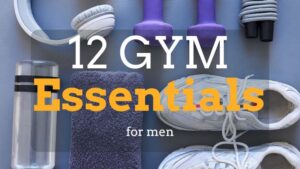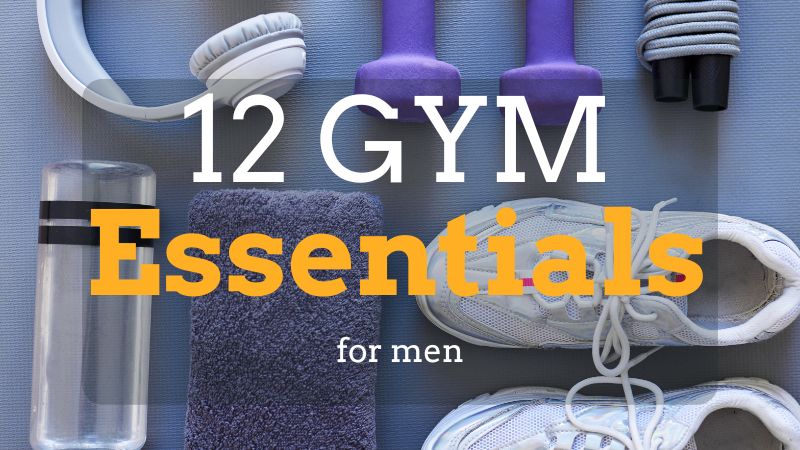
Gym Essentials For Women:A Complete List
Enthusiasts who never miss a session, understanding the gym essentials for women is crucial, not just for what to wear but also for what to

“How often should you go to the gym” is a question that pops up in the minds of many who are considering starting a regular workout regimen. The gym offers a therapeutic and growth-focused environment, not to mention the array of health benefits that come with regular exercise.
If you’re on the fence about getting a gym membership and embarking on a consistent fitness journey, you might also wonder about the ideal frequency of your visits, the types of exercises best suited for your objectives, whether hiring a personal trainer is necessary, and more.
We will delve into various considerations that will help you gauge how frequently you should hit the gym, what workout routines could be most effective for you, among other factors.
While the general guideline suggests making gym visits anywhere from twice to five times a week, it ultimately hinges on what you aim to achieve. Let’s explore the details further.
The answer to how often you should visit the gym varies significantly! The frequency of your gym visits largely depends on your personal fitness objectives.
You might initially think, “obviously, to improve my physical condition!” However, your goals likely extend beyond the surface. Consider your deeper motivations and your history with exercise.
Reflect on your current relationship with physical activity. Is this your first gym membership, or are you reacquainting yourself with a former routine? If your exercise regimen has been sporadic in the past, ponder the reasons behind this. Assess your current physical condition. If you find yourself winded easily, it might be wise to ease into your gym routine gently.
If your goal is to enhance your physical fitness, consider what “in shape” means to you. Do you aim to shed pounds, build muscle mass, or simply feel more vigorous and healthy? What drives your desire to get fit? Whether it’s for boosting self-confidence, health concerns, or achieving a specific feat like finishing a triathlon, identifying your goals is crucial.
As you embark on your fitness journey, keep your specific needs and aspirations in mind. If your aim is to enhance your health or lose weight, your focus may be on aerobic exercises such as running on the treadmill, using the stair climber, elliptical workouts, swimming, and so forth.
Conversely, if your goal is to gain muscle, you might gravitate towards strength training exercises, including curls, bench presses, squats, and more. We’ll explore various scenarios and the recommended workout frequency for each goal.
Determining the optimal frequency of workouts for weight loss is a common question for those aiming to shed pounds. Let’s discuss a general guideline for weekly exercise, keeping in mind that individual differences significantly impact one’s exercise journey.
Before embarking on an exercise plan, assess your current physical condition and set realistic goals. Avoid overexerting yourself initially, and gradually build up your routine to ensure long-term adherence.
So, what’s the recommended exercise frequency for weight loss? Research and expert opinions highlight the efficacy of regular physical activity in promoting weight loss. The American College of Sports Medicine provides guidelines suggesting that moderate-intensity exercise for 150 to 200 minutes weekly (about 2.5 to 3.5 hours) can aid in preventing weight gain. For modest weight loss, 150 to 250 minutes per week (about 2.5 to just over 4 hours) is recommended, and for more significant weight loss, over 250 minutes weekly (more than 4 hours) is advised.
Additionally, combining moderate-intensity exercise with a balanced, moderately restricted diet can enhance weight loss outcomes, according to The American College of Sports Medicine, though severe dietary restrictions are not recommended.
Here’s the bottom line: starting with 150 minutes of exercise per week (approximately 2.5 hours) is a solid baseline for those looking to lose weight.
This equates to roughly 20 minutes daily if exercising seven days a week, or around 30 minutes per day if working out five days a week. For a four-day workout schedule, aim for 40-minute sessions.
Once this becomes manageable, gradually increase your workout duration to reach up to 250 minutes weekly for optimal results.
If 150 minutes per week seems daunting, begin with 100 or even 50 minutes, with the objective of eventually reaching at least 150 minutes of exercise per week.
Understanding the necessary workout duration for shedding pounds is crucial, but what exercises will you incorporate? Which apparatus could prove beneficial? We’ve touched on “moderate intensity physical activity,” but how do we define moderate intensity?
Guidelines from the CDC for adults specify the recommended amount of exercise for maintaining health. They characterize moderate-intensity aerobic exercise as an effort that “increases your heart rate and induces sweating.” Potential activities fitting this description, among others, include:
The objective is to elevate your heart rate and exert sufficiently to perspire. Any healthful activity capable of delivering these outcomes can aid in weight reduction. Remember to pack your gym must-haves when heading to the gym.
If your workout goals lean more towards gaining mass rather than trimming down, you may question whether moderate aerobic exercise is the right strategy for you. Though cardio is beneficial for all, including those aiming to bulk up, muscle development often requires a different tactic than weight reduction. We will delve into the optimal workout frequency, the most effective gym equipment for muscle growth, and beyond.
Before we tackle the best types of equipment and the ideal workout duration, let’s talk about a technical term for building muscle — muscular hypertrophy. “Muscular” relates to the muscles, “hyper” signifies increase, and “trophia” comes from a Greek word meaning nutrition. However, it’s essential to note that muscular hypertrophy comes in two varieties:
Both types are essential and fulfill crucial roles. Though sarcoplasmic muscular hypertrophy may not directly enhance your strength, it aids in sustaining strength over longer periods. It’s akin to boosting your muscles’ energy reserves for workouts. Myofibrillar hypertrophy, on the other hand, can enhance your strength.
In strength training, you’ll experience both types of hypertrophy at varying degrees. To augment the myofibrils in your muscles and strengthen, you should opt for lifting heavier weights with fewer repetitions.
If your goal is to boost endurance and your muscles’ energy capacity, focusing on lighter weights and higher reps to achieve fatigue is advisable. For well-rounded development, it’s beneficial to engage in a diverse range of exercises targeting both aspects.
So, what’s the ideal frequency?
For weight loss, the focus was on the total minutes of exercise per week. For muscle growth, the discussion shifts to the number of weekly workouts. The duration of each strength or resistance training session can significantly vary based on your initial physical condition.
The objective is to challenge yourself beyond your comfort zone, compelling your muscles to adapt to higher demands in weight and repetition, approaching muscle exhaustion.
Although consensus among experts is that at least a weekly workout is necessary for muscle growth, research examining workout frequency suggested minimal difference between training six times a week and three times a week.
Hence, for muscle development, beginning with one or two weekly sessions and progressing to three is advisable. However, increasing from three to six times weekly may not yield significantly different results in effectiveness.
*Reaching a point of exhaustion implies the inability to execute further repetitions, yet it’s crucial not to exert beyond your zone of comfort.
**Research indicates that engaging in strength exercises over thrice weekly doesn’t yield notably greater outcomes than a mere thrice weekly regimen.
As previously mentioned, the essence of weight lifting and muscle growth lies in challenging your muscles beyond their accustomed levels. Importantly, this doesn’t mean overextending or taking on too much too soon. It’s critical during strength training to recognize your boundaries and not exceed them. The goal is to step out of your comfort zone without causing injury.
So, which gym equipment is most effective? Essentially, any tool that helps intensify your muscle engagement could be beneficial. Here’s a concise list for your consideration:
For those new to free weights, it might be wise to seek advice from a personal trainer to master the correct techniques for each exercise to avoid injury. Resistance bands or body weight exercises are also viable options.
Perhaps your goals don’t include bulking up or slimming down; instead, you’re focused on maintaining overall health and keeping your physique in top condition! Exercise serves as a fantastic method to enhance well-being and boost energy levels. But what’s the necessary frequency and duration for workouts? And what kinds of activities should you consider?
Once more, the CDC offers valuable guidance on the exercise regimen adults should pursue for optimal health. They suggest:
Though this level of activity may not lead to substantial muscle gains or dramatic weight loss, it’s an excellent starting point for those looking to improve health and increase activity levels.
Optimal gym equipment/classes for fitness maintenance
For maintaining fitness, target 150 minutes of combined cardiovascular and strength training exercises, though with a balanced focus on each. Consider two 40-minute cardio workouts, possibly on the treadmill or in a spin class, alongside two 40-minute sessions in a weight training circuit that engages all major muscle groups. If finding motivation is challenging, joining a group fitness class might help.
Here’s a suggested exercise plan to keep fit:
Deciding on the optimal time for gym visits is subjective and varies based on individual lifestyle, energy levels, and commitments. While there’s no one-size-fits-all answer, understanding your body’s rhythms and daily schedule can guide you in choosing the most effective time for your workouts. Here are some considerations:
The frequency of your gym visits, “How often should you go to the gym,” should align with your fitness goals, lifestyle, and personal preferences.
Whether you aim to lose weight, gain muscle, maintain overall health, or simply boost your energy levels, the key is finding a routine that you can consistently follow.
Starting with the recommended 150 minutes of physical activity per week and adjusting based on your objectives and how your body responds is a solid strategy.
Remember, the journey to fitness is personal and adaptable to your changing needs and ambitions. Additionally, staying hydrated during your workouts is crucial for optimal performance and recovery.
Carrying a water bottle to the gym ensures you maintain adequate hydration, supporting your health and fitness journey. Ultimately, the best gym routine is one that fits seamlessly into your life and helps you achieve your wellness goals.
Is it necessary to hire a personal trainer when I first join the gym?
While not mandatory, a personal trainer can provide tailored advice, ensure you’re performing exercises correctly to avoid injury, and help you meet your fitness goals more efficiently. Especially if you’re new to the gym environment, a personal trainer can be a valuable resource for getting started on the right foot.
Can I still benefit from going to the gym if I can only commit once a week?
Yes, any physical activity is better than none. While more frequent visits may yield faster or more pronounced results, a well-structured workout once a week can still contribute to your overall health and fitness, particularly if complemented by active lifestyle choices outside the gym.
How do I choose the right type of exercise for my fitness goals?
Start by clearly defining your goals (e.g., weight loss, muscle gain, endurance improvement). Research or consult with a fitness professional to understand which exercises and workout routines align with those objectives. For example, weight lifting is key for muscle gain, while a mix of cardio and strength training can be effective for weight loss.
What should I do if I start feeling bored with my gym routine?
Mixing up your routine is crucial to stay motivated and avoid hitting a plateau. Try new classes, adjust your workout split, set new fitness goals, or challenge yourself with different equipment. Keeping your workouts varied can reignite your enthusiasm and lead to better results.
How does creatine intake affect my water needs during workouts?
Creatine supplementation can increase your muscles’ water content, potentially enhancing your performance and aiding in muscle recovery. However, this also means your body may require more water to stay hydrated. It’s essential to increase your water intake when using creatine to prevent dehydration, especially during intense workouts. Aim for at least an additional 16-20 ounces of water daily on top of your regular needs, but listen to your body and adjust as necessary.


Enthusiasts who never miss a session, understanding the gym essentials for women is crucial, not just for what to wear but also for what to

A common myth circulating in the fitness world is the belief that a gym diet plan is unnecessary. Many seem convinced that they can simply

The average bench press, often referred to humorously in gyms as ‘How much ya bench’ or ‘whaddaya bench?’, stands as a quintessential measure of strength

Nowadays, we always seem to be packing a bag for something. Whether it’s getting ready for work with your messenger bag or briefcase, filling up

Enthusiasts who never miss a session, understanding the gym essentials for women is crucial, not just for what to wear but also for what to

A common myth circulating in the fitness world is the belief that a gym diet plan is unnecessary. Many seem convinced that they can simply

The average bench press, often referred to humorously in gyms as ‘How much ya bench’ or ‘whaddaya bench?’, stands as a quintessential measure of strength

Nowadays, we always seem to be packing a bag for something. Whether it’s getting ready for work with your messenger bag or briefcase, filling up
Copyright © 2025 remindsmartbottles. All Rights Reserved.
Copy the coupon code below and fill it in when you purchase to enjoy!
newuser